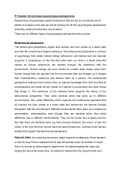Prof. Dr. Baum
1. Fachsemester
Hochschule Fresenius, Frankfurt am Main
Luca Loreen Kraft
Psychologie, M. Sc.
,Inhaltsverzeichnis
Inhaltsverzeichnis .......................................................................................................................................... I
1 Beast of Bias ............................................................................................................................................ 1
1.1 Ausreißer .............................................................................................................................................................................. 2
1.2 Annahmen ............................................................................................................................................................................. 4
1.3 Überprüfen der Voraussetzungen .............................................................................................................................. 6
1.3.1 Testen auf Ausreißer ......................................................................................................................................................... 6
1.3.2 Testen von Linearität und Homoskedastizität ...................................................................................................... 8
1.3.3 Testen auf Homoskedastizität ...................................................................................................................................... 9
2 Missings – Umgang mit fehlenden Werten ................................................................................. 11
2.1 Entstehung fehlender Werte ...................................................................................................................................... 11
2.2 Typen und Muster ........................................................................................................................................................... 11
2.3 Imputationen ..................................................................................................................................................................... 15
2.3.1 Strategien im Umgang mit fehlenden Werten .................................................................................................... 15
2.3.2 Regressionsimputation ................................................................................................................................................. 16
2.3.3 Expectation maximization .......................................................................................................................................... 16
2.3.4 Multiple Imputation („data augmentation“) ...................................................................................................... 16
3 Multiple Regression............................................................................................................................ 18
3.1 Multiple lineare Regression ........................................................................................................................................ 18
3.1.1 Exkurs: Dummy Codierung .......................................................................................................................................... 18
3.1.2 Einfachster Fall_ Zwei Prädiktoren ......................................................................................................................... 19
3.1.3 Interpretation Beta-Gewichte .................................................................................................................................... 22
3.1.4 Exkurs: Partielle vs. Semipartielle Korrelation .................................................................................................. 24
3.1.5 Multiple Regression ........................................................................................................................................................ 25
3.1.6 Determinationakoeffizient – einfache Regression ............................................................................................ 25
3.1.7 Signifikanttest: Modell .................................................................................................................................................. 27
3.1.8 Signifikantest Steigungskoeffizient ......................................................................................................................... 27
3.2 Anwendung ........................................................................................................................................................................ 29
3.2.1 Annahmen ........................................................................................................................................................................... 29
3.2.2 Selektionsverfahren ........................................................................................................................................................ 32
4 Logistische Regression ...................................................................................................................... 35
4.1.1 Ablaufschritte einer logistischen Regression ...................................................................................................... 37
Multivariate Verfahren I
, 4.1.2 Grundlegende Zusammenhänge der logistischen Regression ...................................................................... 38
4.1.3 Interpretation der Regressionskoeffizienten....................................................................................................... 39
4.2 Interpretation Odds Ratio ............................................................................................................................................ 41
4.2.1 Wirkung einer Vergrößerung von X um eine einheit bei Positivem und Negativem
Regressionskoeffizienten .............................................................................................................................................................. 42
4.2.2 FACHARTIKEL: Interpretieren der Ergebnisse indem Sie einen Antwortsatz bilden ........................ 42
4.3 The Log-Likelihood – Prüfung des Gesamtmodells .......................................................................................... 43
4.3.1 R & R2 (Pseudo-R2-Statistik) ...................................................................................................................................... 43
4.3.2 The Wald Statistic ........................................................................................................................................................... 44
4.3.3 Builiding the Model......................................................................................................................................................... 44
4.3.4 Things that can go wrong ............................................................................................................................................ 45
4.3.5 The Process ......................................................................................................................................................................... 46
5 Univariate Varianzanalysen ............................................................................................................ 47
5.1.1 Univariate vs. Multivariate Varianzanalyse ........................................................................................................ 47
5.1.2 Warum Varianzanalyse? .............................................................................................................................................. 47
5.2 Typen der Varianzanalyse ........................................................................................................................................... 48
5.2.1 Terminologie der Varianzanalyse ............................................................................................................................ 50
5.2.2 Voraussetzung der Varianzanalyse ......................................................................................................................... 50
5.3 Das Grundprinzip der Varianzanalyse ................................................................................................................... 50
5.3.1 Die Varianz ......................................................................................................................................................................... 51
5.3.2 Die Gesamtvarianz .......................................................................................................................................................... 51
5.3.3 Zerlegung der Gesamtvarianz.................................................................................................................................... 52
5.3.4 Die Schätzung der Residualvarianz (nicht erklärte Streuung) ................................................................... 54
5.3.5 Quadratsummen .............................................................................................................................................................. 55
5.4 Prüfung statistische Signifikant – der F-Bruch ................................................................................................... 55
5.4.1 Die Null-Hypothese ......................................................................................................................................................... 55
5.5 Effektstärke ........................................................................................................................................................................ 56
5.5.1 Die Alternativhypothese der Varianzanalyse...................................................................................................... 57
5.6 Beispielrechnung ............................................................................................................................................................. 57
5.7 Mehrfaktorielle ANOVA ................................................................................................................................................ 59
5.7.1 Nomenklatur ..................................................................................................................................................................... 59
5.7.2 Effektarten.......................................................................................................................................................................... 60
5.8 Definition der Wechselwirkung ................................................................................................................................ 65
5.8.1 Ordinale Wechselwirkung ........................................................................................................................................... 65
5.8.2 Semiordinale Wechselwirkung .................................................................................................................................. 66
5.8.3 Disordinale Wechselwirkung ..................................................................................................................................... 67
5.9 Voraussetzungen ............................................................................................................................................................. 68
Multivariate Verfahren II
, 5.10 Varianzzerlegung ............................................................................................................................................................. 68
6 Multivariate Varianzanalyse (MANOVA) ..................................................................................... 69
6.1 Uni- vs. Multivariate Varianzanalyse ...................................................................................................................... 69
6.1.1 Fragestellung für MANOVA ......................................................................................................................................... 70
6.2 MANOVA – Hypothesentestung ................................................................................................................................. 71
6.2.1 Analyse der Varianzen................................................................................................................................................... 71
6.2.2 Additivität der Quadratsummen............................................................................................................................... 72
6.3 Prüfgrößen bei der MANOVA ..................................................................................................................................... 73
6.3.1 Wilk’s Lambda .................................................................................................................................................................. 73
6.3.2 Auswahl der Multivariaten Prüfgröße ................................................................................................................... 74
6.3.3 Post Hoc Tests ................................................................................................................................................................... 75
6.3.4 Übersicht der Post-Hoc Tests ...................................................................................................................................... 76
6.3.5 Univariate Varianzanalyse.......................................................................................................................................... 76
6.3.6 Diskriminanzanalyse ..................................................................................................................................................... 76
6.3.7 Multivariate Kontraste ................................................................................................................................................. 77
6.3.8 Voraussetzungen ............................................................................................................................................................. 78
6.3.9 Varianzgleichheit/ Homoskedastizität .................................................................................................................. 79
6.3.10 Multikollinearität....................................................................................................................................................... 79
7 Repeated ANOVA ................................................................................................................................. 80
7.1.1 Arten von Faktoren ......................................................................................................................................................... 80
7.1.2 Versuchspläne mit Messwiederholung ................................................................................................................... 80
7.2 I. Rep ANOVA: 1 MW Faktor | Einfaktorielle Varianzanalyse mit Messwiederholung ...................... 81
7.2.1 Zerlegung der Gesamtvarinaz.................................................................................................................................... 81
7.2.2 Treatmenteffekt ............................................................................................................................................................... 83
7.2.3 Signifikanzüberprüfung der Effekte ........................................................................................................................ 84
7.2.4 Varianzzerlegung ............................................................................................................................................................ 86
7.2.5 Signifikanzprüfung und F-Bruch-Bildung ............................................................................................................ 87
7.2.6 Bewertung der Messwiederholung .......................................................................................................................... 88
7.3 Voraussetzung – Varianzanalyse mit Messwiederholung ............................................................................. 88
7.3.1 Voraussetzung: Unabhängigkeit der Messungen .............................................................................................. 88
7.3.2 Sphärizität .......................................................................................................................................................................... 89
8 Clusteranalyse ...................................................................................................................................... 91
8.1 Vorgehen ............................................................................................................................................................................. 92
8.1.1 Dichotome Variablen ..................................................................................................................................................... 93
8.1.2 Koeffizient ........................................................................................................................................................................... 93
8.1.3 Bestimmung der Ähnlichkeit ...................................................................................................................................... 94
Multivariate Verfahren III





